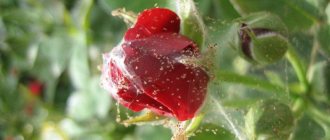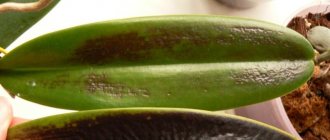Many gardeners are sure that a varietal rose leaf should consist of 5 leaves, but another number means that you have been sold a rose hip. Is this really so, and when do you need to deal with the “wrong” growth, fearing the degeneration of the rose?
Modern garden centers most often sell roses without leaves, with stems sealed with wax, and even in pots where the grafting site is not visible. The bright picture on the package promises you a seedling of European selection, but when planted in the ground the plant produces leaves with seven lobes. What did you buy and is it worth urgently digging up the flower to return it to the unscrupulous seller?
How many leaves should a rose have?
Experienced gardeners are sure that the correct answer to the question of how many leaves a rose has is 5 pieces. Only rose hips can have a larger amount. This opinion appeared at a time when the number of varieties was quite limited.
rose foliage
Today there are at least 30 thousand types of roses in the world, and many new varieties appear every year. They can have 3, 5, 7, 9, 11, 13 leaf plates. The number does not indicate whether the bush belongs to a garden or wild crop.
Important! The non-standard number indicates the domestication of the subspecies. When a new variety is obtained, the hybrid is capable of producing both 7 and 9 plates.
Differences between climbing roses and simple and bush varieties of roses
During the growing season, it is difficult to confuse bush, standard, simple and climbing roses. Its characteristic features include:
- The climbing rose has 7 leaves;
- shoots reach from 3 to 5 m;
- the crown is spreading, the branches are highly flexible, they can easily be placed in a shelter before wintering;
- leaf blades are painted in dark green tones;
- the plant needs support.
The leaves of a rose are drying up - what could be the reasons?
A simple count of leaves does not give anything; when purchasing a seedling, special attention should be paid to the place where the stems and roots grow together. Almost all young animals from bush and ordinary representatives are obtained by vaccination. The cultural bud is planted:
- on rose hips - budding;
- on the rootstock of a wild relative - copulation.
At the junction, in the area of the root collar, a thickening is formed. It is used to determine the variety and whether it belongs to a climbing or regular subspecies.
Variants capable of weaving are propagated by cuttings and layering. They are classified as self-rooted - climbing roses do not have additional growth in the root collar area. Vaccinations of such varieties are carried out only when necessary, if this is required by the characteristics of the breeding origin.
Such knowledge is needed for beginning flower growers. In a nursery or agricultural complex, young animals are sold in containers with open or closed root systems, and a wax layer is applied to the branches. When purchasing, you need to take a closer look at the root collar; if the plant is to curl, then it will not have any foreign growths in the specified area. The advantage of climbing species is the absence of secondary wild growth and the impossibility of gradual degeneration.
Important! When choosing a seedling, special attention should be paid to the area located below the scion. If a living bud is localized there, the flower quickly transforms into a wild one, which is difficult to fight.
Bush and climbing variety
How to properly trim rose shoots
Spring pruning
Before the pruning process, it is necessary to remove the cover from the crops, eliminate debris, all old foliage and rake away the mulch. Then cut off the roses when warm weather conditions have established, the buds have swollen, but the shoots have not yet begun to grow. During this period, sanitary pruning is carried out.
If the bush is too dense, thin it out and leave four or five strong stems. All cuts should be made using sharp pruners, which cause as little trauma to the crop as possible. Cut the shoots at an angle of forty-five degrees, stepping back half a centimeter from the bud.
When pruning in spring, the bush is given the necessary shape and the shoots are shortened to activate the flowering process.
Summer pruning
During the summer season, sanitary and formative pruning of bushes continues. Remove wild growth, dried branches and wilted flowers by shortening the stem. Roses older than three years in the last summer month often send out a large number of young shoots, thickening the bush and forming shade. Because of this, fungal diseases can develop; therefore, during the summer period, excess shoots must be removed.
Trimming roses after flowering
She should be given special attention. By removing wilted inflorescences, you prolong the flowering of roses, which may not expend energy on fruit formation
By removing wilted inflorescences, you prolong the flowering of roses, which may not expend energy on fruit formation.
On roses that have more than one bud on one stem, cut off the entire tassel above the top five-leaf clover.
Trimming faded inflorescences
Withered buds of hybrid tea roses (producing one flower per stem) are cut differently.
Towards the end of the summer, remove only wilted flowers. In climbing ramblers, when flowering is over, the tassels are removed down to the first leaf. This can help the shoots branch so that flowers can bloom on them next year.
How to distinguish a rose from a rose hip
Both options are considered close relatives:
- Rosehip is able to take root in various conditions and is characterized by a high level of endurance. Heat and severe frosts do not affect it; by nature it has strong roots, it does not need pruning or feeding. The root system independently provides the bushes with the necessary nutrients, extracting them directly from the soil.
- The rose is distinguished by its tenderness and capriciousness; it blooms only with proper care. By the number of leaves it is easy to distinguish between domestic and wild counterparts.
How to revive roses after winter - what to do
The main signs that help to recognize them include:
- The branches of rose bushes have a reddish tint, and over time the shoots turn green. Rosehip individuals initially have greenish shoots that are thrown out from the roots, while in roses they appear above the point of contact between the root system and the stem.
- The thorns of the cultivated variety are sparsely growing and have large spines. “Wild” shrub has small, sharp and thin thorns.
- Rose bushes are decorated with bright and glossy leaf blades. In rose hips they are smaller, with curves clearly visible at the tip.
Important! Rosehip has 7 leaves on its petiole, the same number is found in its cultivated counterparts.
Shoot differences
What is their difference?
“Nature raised the wild rose...” All the variety of plants of the genus Rose that is observed in the surrounding world has one progenitor - an inconspicuous, wild rose with small, white flowers.
Rose hip
There is only one ancestor, but thanks to the centuries-old efforts of gardeners and breeders, cultivated plants appeared, so much so that it would be a stretch to call a wild rose a rose. And so she became a rosehip. Moreover, for the many thorns on the stems, which is typical of all deciduous or evergreen shrubs of the Rosa genus. Despite the prickly nature of the plant's stem, since ancient times different peoples have composed legends about the wonderful flower, sang in poetry and prose its beauty and delicate aroma.
Blooming rosehip
Having successfully survived centuries, a wild rose or wild rose continues to grow in various parts of our Earth, only changing in accordance with the climate of a particular area. In Russia alone, there are more than 40 species of wild rose and they can be found on forest edges and meadows, along river banks and along roads. During flowering, the shrub is covered with single or collected in inflorescences flowers of white, pink, and carmine shades. Having met him in the lap of nature, we can safely say that this is a wild rose. No rose with its whimsical nature can survive in such conditions as its wild relative “blooms and smells.”
What to do with the rest of the cultivated representatives of the Rose genus, encountered at every step in the civilized world? Encountering them in parks and squares, inhaling the aroma and admiring the flowering bushes, suddenly a doubt creeps in that not all this splendor and riot of colors are roses. There must be a rosehip here somewhere. Yes, cultivated beyond recognition, but still a rosehip.
What roses have 7 leaves?
Is it necessary to bury a rose graft when planting?
Long-term selective selection has improved the quality characteristics of roses. The process continues to this day in nurseries and institutes, which makes it possible to obtain new varieties. But the work done could not completely change the gene pool and the plant regularly appears with a non-standard number of foliage.
How many leaves does a climbing rose have? Polka and Flammentanz have 7 sheets each. A similar amount is found in park ground cover species. These include Lipstick and Kleinstrauhrose. The same feature is found in Floribunda, which belongs to the Pilgrim. Their decorative effect does not suffer from the number of plates. The five-leaved subspecies included Monica, Flamingo and Paradise.
Rose Polka
What to do if a rose degenerates into a rose hip
The gradual wilding of a varietal plant disheartens any gardener. This anomaly is observed in grafted varieties, when a weak culture is attached to a strong base. In this situation, the root system throws out its own shoots and if the problem is not dealt with, the scion quickly dies.
Important! The identification of wild game occurs through a thorough examination of the bush. It begins to grow a short distance from it or is located exactly under the bush. In some cases, shoots appear up to 2 m from the mother plant.
The emerging green branch is distinguished by increased thorniness and 7 leaf blades on the petiole. It develops and grows rapidly, after a few months it thickens and grows up to 1.5 m.
You can prevent this unpleasant phenomenon when purchasing seedlings - they should be purchased from trusted places. There should be no living growth buds on the rootstock. The threat of degeneration can be reduced if the root collar, when planting, is initially deepened to the bayonet of a shovel, and not 5 or 7 cm.
Wild growth near a rose
When foreign growth appears, the following measures are taken:
- In the area where the shoot appears, you need to remove the soil to get to the root system. This approach will help determine the growing area of the game.
- Trim the wild shoot using pruning shears. The cut should be deep, capturing part of the root.
- The pruning area must be disinfected with iodine solution, the soil should be leveled and compacted in the area around the trunk.
- After three days, spray the entire plant, including leaf blades, with a water-superphosphate mixture (50 g per 1 liter of heated liquid, the composition is additionally diluted in a bucket of water). The manipulation should be repeated several times during the season.
Important! Wild shoots should not be cut at soil level - this will lead to increased bushiness and complicate the fight against unwanted growth.
Preventive cutting is carried out as the rose hip shoots form. The desired result is not always achieved from the first treatment. To preserve the varietal qualities of the rose, it should be transferred to its own root system:
- Immediately after the ground thaws in early spring, dig a ditch near the bush.
- Place last year's stem in it and secure along the entire length with pins. Leave the tip of the branch in a vertical position.
- Sprinkle a mixture of peat and humus on top. Care for the cuttings all summer, during which time they take root.
- Cutting from the mother bush is carried out the next season, at the same time the shoot must be transferred to a new place.
Important! This method of propagation is suitable for varieties that have increased frost resistance.
The process of degeneration is characterized by an accelerated pace due to a lack of useful substances in the graft. Depleted soil and insufficient bait provoke a lag in the development of roses and active growth of the root system of the base.
All procedures must be carried out on a proactive basis. Every month you need to inspect the area of the root collar, and break off the emerging shoots. They tend to grow parallel to the soil surface for more than a meter before emerging.
Removing wild shoots
How to preserve roses in a bouquet using little tricks
If the roses in the bouquet have already been treated with special chemicals, then you can safely drop dishwashing detergent or laundry bleach into the vase: such chemicals will not harm the roses; on the contrary, they will help them stay in the water for as long as possible, maintaining a fresh appearance. Drops of ammonia added to a vase of water will help make roses stand in a vase. The larger the bouquet, the higher the concentration of ammonia should be. You can also dip the flowers in boiling water for five minutes, and then put them in cold water. Another more complicated option: place the roses overnight in a bathtub filled with cool water, but again so that the buds and flowers themselves do not get wet
However, you will have to perform this procedure every night, since the roses will quickly get used to being immersed in water at night and will feel uncomfortable in the vase. When buying a bouquet, pay attention to the type of roses: the flower heads must be closed so that the petals are tightly adjacent to each other.
How to brush your teeth correctly: the secrets of a beautiful smile
Which roses don't run wild
Wild growth cannot be found on rose bushes with their own roots. If they were not initially grafted onto the base, then they are not in danger of going wild. This type of shrub is not able to withstand adverse weather conditions: sudden changes in temperature or harsh winter. They require winter shelter:
- climbing varieties must be placed in trenches, having first been removed from the trellises;
- Cover the bushes with spruce branches and mulch.
Own-root varieties take root well in the southern regions, and flower beds in the middle and northern latitudes will become impoverished without grafted roses. Therefore, flower growers will have to regularly fight wild growth.
In order not to look for the answer to the question of how many leaves a garden rose should have, it is enough to familiarize yourself with the varietal characteristics of the young plants. Grafted varieties may have 5, 7 or 9 leaf blades located on the petiole. To prevent them from going wild, it is necessary to regularly remove foreign shoots growing from the root system of the base.
Freezing of roses
If you did not cover your roses well enough for the winter or opened them too early in the spring, the plants may face another problem - freezing. First of all, the darkened (sometimes to black) shoots will “tell you” about this.
If the damage is minor, the shoot will “come to its senses” on its own, but if the frost is severe, the rose stems may begin to dry out - such shoots will have to be cut down to living tissue with sharp pruning shears. When it gets warmer, open the roses completely and carry out sanitary and formative pruning. Damaged plants should be fed with complex fertilizer and also treated with a growth stimulator.
To prevent this from happening in the future, take a responsible approach to the process of covering roses in winter and opening them in spring.
How to properly cover roses for the winter - the best options for winter shelter It's time to cover roses for the winter. Read the article on how to do this quickly and at minimal cost.
Rules for removing winter cover from roses Do everything right so that roses will delight you with blooming inflorescences in summer!











